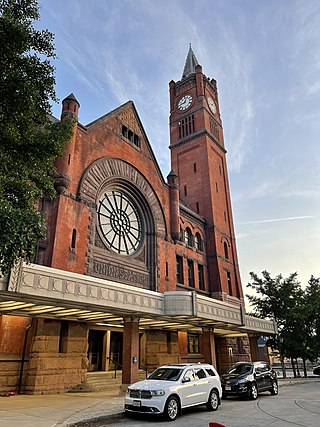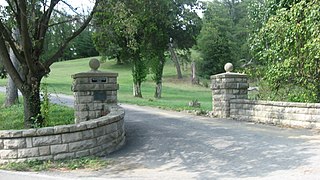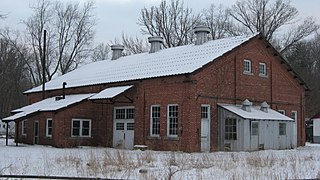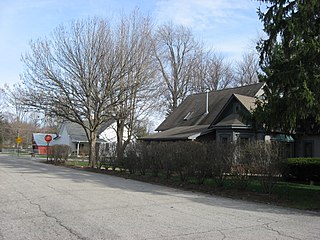
Dearborn Station was, beginning in the late 1800s, one of six intercity train stations serving downtown Chicago, Illinois. It remained in operation until May 1, 1971. Built in 1883, it is located at Dearborn and Polk Streets, to the south of the Loop, adjacent to Printers Row. The station was owned by the Chicago & Western Indiana Railroad, which itself was owned by the companies operating over its line. The station building headhouse now houses office, retail, and entertainment spaces, and its trackage yard, behind the headhouse, was redeveloped into part of the Dearborn Park neighborhood.

Culbertson Mansion State Historic Site is located in New Albany, Indiana by the Ohio River. It was the home of William Culbertson, who was once the richest man in Indiana. Built in 1867 at a cost of $120,000, this Second Empire-style mansion has 25-rooms within 20,000 square feet (1,900 m2), and was completed in November 1869. It was designed by James T. Banes, a local architect. Features within the three-story edifice include hand-painted ceilings and walls, frescoed ceilings, carved rosewood-grained staircase, hand painted floors, wall-to-wall carpeting, marble fireplaces, wallpaper of fabric-quality, and crystal chandeliers. The original tin roof was imported from Scotland. The displays within the mansion feature the Culbertson family and the restoration of the building. The rooms on the tour are the formal parlors, dining rooms, bedrooms, kitchen, and laundry room.

The Indianapolis Union Station is an intercity train station in the Wholesale District of Indianapolis, Indiana. Currently, Amtrak's Cardinal line serves the terminal, passing through Indianapolis three times a week.

Lafayette station is an Amtrak station in Lafayette, Indiana, served by the Cardinal. The current station facility was established in 1994. The Amtrak train previously stopped in the middle of the city's 5th Street, near the former Monon Railroad depot. The station building was moved to its current location from the southeast corner of 2nd and South streets in September 1994. It is a Romanesque Revival style depot built in 1902 by the Lake Erie and Western Railroad and Cleveland, Cincinnati, Chicago and St. Louis Railway, as the Big Four Depot. The station was listed on the National Register of Historic Places in 2003.

The New Albany Downtown Historic District is a national historic district located at New Albany, Indiana. The general area is W. First Street to the west, Spring St. to the north, E. Fifth Street to the east, and Main Street to the south. The local specification of the district is between East Fifth Street to West Fifth Street, Culbertson Street to the north, and the Ohio River to the south. East Spring Street Historic District is immediately east of the area, and the Main Street section of the Mansion Row Historic District starts. The area includes the Scribner House, where the founders of New Albany lived. It is also the focal area of the Harvest Homecoming Festival every October.

The East Spring Street Historic District is a national historic district located at New Albany, Indiana. The general area is E. Fifth Street to the west, Spring St. to the north, E. Eighth Street to the east, and Market Street to the south. The Cedar Bough Place Historic District is one block north of the area, the New Albany Downtown Historic District is immediately west of the area, and the Market Street section of the Mansion Row Historic District starts. The district encompasses 84 contributing buildings in a largely residential section of New Albany. It developed in the late-19th and early-20th century and includes notable examples of Queen Anne and Italianate style architecture. Notable buildings include the Third Presbyterian Church, St. Mary's Roman Catholic Church and Rectory, the former John Conner House or Masonic Lodge, and Edwards City Hospital.
The Sweet Gum Stable, also known as Farmer's Feed and Supply, was located at the southeast corner of Main and W. Seventh Street in New Albany, Indiana. The property was a stop of the Underground Railroad, ten blocks west of another stop, the Town Clock Church, and a mere block away from the River Jordan for fugitive slaves, the Ohio River. The stable was built in 1877, and consisted of a balloon frame stable with an attached small brick and frame dwelling constructed about 1836. A feed store was added to the building in 1886. The structured measured 60 feet by 120 feet and encompassed the entire lot.

Woodbine, also known as the Anders Rasmussen House, is a historic early-20th-century estate located at New Albany, Floyd County, Indiana. It was built in 1920 for Anders Rasmussen, who owned a florist business in New Albany and once served as a florist for the King of Denmark. The 2+1⁄2-story Bungalow / American Craftsman-style house is made of stucco, brick, limestone, asphalt, and terra cotta, with a full basement. The house includes a 1+1⁄2-story caretaker's apartment. The house stayed with the family until 1945, and has gone through several hands since then. The estate is currently owed and being restored by the owner/winemaker for Downtown New Albany's River City Winery located just two miles away. Plans for a vineyard on the estate are underway.

Salem station is an Amtrak train station in Salem, Oregon, United States. It is served by Amtrak Cascades corridor trains going to and from Portland, Oregon, as well as the long-distance Coast Starlight. Greyhound Lines and some regional buses also stop at the station.

The Richmond Railroad Station Historic District is a group of historic commercial buildings and national historic district located at Richmond, Wayne County, Indiana.

Linden Depot is a historic train station located at Linden, Montgomery County, Indiana. In 1852 the New Albany and Salem Railroad Railroad cut through Montgomery County, Indiana. The old stage road between Crawfordsville and Linden was given to the railroad as an inducement to get them to build through Linden. 1852 also saw the building of the first Linden depot, on a site behind the present day Post Office. The building was moved to the current location in 1881 when the Toledo, St. Louis and Western Railroad was built through Linden, crossing the Monon at this location.

Hobart, also known as The Pennsy Depot, is a disused train station in Hobart, Indiana. It was built in 1911 and listed on the National Register of Historic Places in 1984 as the Pennsylvania Railroad Station.

The Pennsylvania Railroad Station in Fort Wayne, Indiana, also known as Baker Street Station, is a former passenger rail station in downtown Fort Wayne, Indiana. The American Craftsman-style station opened to the public March 23, 1914, at a cost of $550,000.

Craigville Depot is a historic train station located in Jefferson Township, Allen County, Indiana, USA. It was built in 1879 and is a one-story, wood-frame building, measuring 16 feet wide, 32 feet long and 16 feet 6 inches high. The gable roof has a four-foot overhang and elaborate Stick Style / Eastlake movement ornamentation. The building was moved from its original location in 1950 and again in 1979. It was restored by Edward Byer who was the owner of the New Haven and Lake Erie Railroad.

New Haven station is a historic train station located at New Haven, Allen County, Indiana. It was built in 1890 by the Wabash Railroad. It is a one-story, wood-frame building, with Stick Style / Eastlake movement ornamentation. It measures approximately 50 feet long and 20 feet wide and has a gable roof and board and batten siding.

Tide Water Pumping Station, also known as Benton Station and SOHIO Pumping Station, is a historic pumping station complex and national historic district located in Harrison Township, Clay County, Indiana. The complex includes the 1+1⁄2-story, brick gale roofed pump house (1915); frame warehouse; a metal shed; two Queen Anne style dwellings; a metal garage; a concrete sluice and bridges; and the remains of a tennis court, dam and pond, and buried pipes. It is one of 14 pumping stations built along a 546.16 mile oil pipeline built between Crawford County, Illinois and Rixford, Pennsylvania. The station closed about 1957.

Fort Harrison Terminal Station, also known as Fort Harrison Post Office, is a historic train station located at Fort Benjamin Harrison in suburban Lawrence Township, Marion County, Indiana, northeast of Indianapolis, Indiana. It was built in 1908, and is a one-story, brick building with Prairie School and Bungalow / American Craftsman style design elements. It has a low, double pitched hipped roof sheathed in metal. It served as a terminal for the interurban Union Traction Company until 1941, after which it housed a U.S. Post Office. It has been converted into a Mexican restaurant.

New Augusta Historic District is a national historic district located at Indianapolis, Indiana. It encompasses 114 contributing buildings, 1 contributing structure, and 1 contributing object in a railroad oriented village in Indianapolis. The district developed between about 1852 and 1939, and includes representative examples of Italianate and Bungalow / American Craftsman style architecture. Notable contributing buildings include the Odd Fellows Building, Hopewell Evangelical Lutheran Church, Salem Lutheran Church (1880), and New Augusta Depot. It is located west of Augusta.

Louisville and Nashville Railroad Station, also known as L & N Station, was a historic train station located in downtown Evansville, Indiana. It was built in 1902 for the Louisville and Nashville Railroad, and was a Richardsonian Romanesque style rock-faced limestone building. It consisted of a three-story central block with two-story flanking wings, and a one-story baggage wing. It had projecting gabled pavilions and a slate hipped roof.
New Albany and Salem Railroad Station, also known as the Louisville and Nashville (Monon) Railroad Station, was a historic train station located at Gosport, Owen County, Indiana. It was built between 1854 and 1858 by the New Albany and Salem Railroad. It was a one-story, simple brick structure measuring 58 feet wide by 123 feet long. It has been demolished.





















